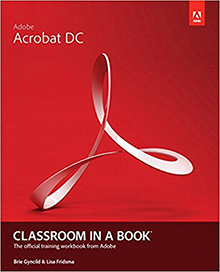GCMW 103: Interactive Publishing

Adobe Acrobat is an essential tool in today's electronic workflow. You can use Acrobat to create virtually any document in Adobe Portable Document Format (PDF), preserving the exact look and content of the original with fonts and graphics. Acrobat also provides native support for Flash technology, so you can be sure that multimedia components in a PDF will play smoothly.
This hands-on course looks at a comprehensive range of print, Web, and multimedia features in Adobe Acrobat and InDesign for creating and distributing electronic documents reliably and securely. Topics and projects include e-books, forms, editing, prepress, accessibility, capture, and a variety of methods to convert and repurpose documents. Students will learn to navigate and search documents, produce interactive, multimedia Web page content, as well as design and format EPUB and iBooks for Kindle, iPad, iPhone and other ereaders.
Portable Document Format

PDF (Portable Document Format) was introduced in 1990 as a way to reliably view, print, and share information with other people. Regardless of the computer's operating system, PDF was reliable and consistent, displaying and printing the same every time. As an open specification, it allowed everybody to peek under the hood to see how PDF was built, leading to a broader understanding and confidence in the young document format.
PDF started off on the dream of a paperless office, as the pet project of one of Adobe's founders, John Warnock. Initially it was an internal project at Adobe to create a file format so documents could be spread throughout the company and displayed on any computer using any operating system. These documents could be viewed on any machine and any selected document could be printed locally. This capability would truly change the way information is managed.
With the Internet boom came a huge increase in the distribution of information as well as an increase in the number of computers, web browsers, and operating systems. During this period of unprecedented growth, PDF emerged as the best way to reliably distribute documents across the web. With Adobe's stewardship, PDF has been adopted by the International Organization for Standardization (ISO) as the standard for archiving electronic documents. One by one, more than a half billion people who use their computers and mobile phones to view, print, and collaborate on documents and forms have come to trust PDF.
PDF files look like original documents and preserve source file information — text, drawings, multimedia, video, 3D, maps, full-color graphics, photos, and even business logic — regardless of the application used to create them and even when compiled from multiple formats into a single PDF Portfolio.
Today, there are more than 200 million PDF documents posted on the web. PDF is the choice of government agencies across the globe. More than 1,800 vendors in the PDF ecosystem, worldwide, offer PDF-based solutions including technologies PDF creation, plug-in, consulting, training, and support.
Gregory Kelley, MA
Palomar College, Adjunct Faculty
Graphic Communications Department

